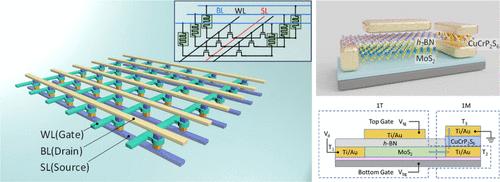节能神经形态阵列的单晶体管-单铁电-忆阻器结构的范德华斯工程
IF 9.1
1区 材料科学
Q1 CHEMISTRY, MULTIDISCIPLINARY
引用次数: 0
摘要
基于二维材料的忆阻器阵列有望用于以数据为中心的应用,如人工智能和大数据。然而,访问单个忆阻器单元并有效控制潜流路径仍然具有挑战性。在这里,我们提出了一种范德华工程方法,通过将新兴的二维铁电CuCrP2S6与MoS2和h-BN组装在一起,来制造一晶体管一记忆电阻器(1T1M)电池。该存储单元具有高电阻可调性(106),低潜流(120 fA)和低静态功率(12 fW)。实验证明了一种大大减少串扰的神经形态阵列。非挥发性电阻开关是由电场诱导的铁电极化反转驱动的。这种范德华工程方法为下一代人工神经网络创建紧凑、节能的二维内存计算系统提供了一种通用的解决方案。本文章由计算机程序翻译,如有差异,请以英文原文为准。

Van der Waals Engineering of One-Transistor-One-Ferroelectric-Memristor Architecture for an Energy-Efficient Neuromorphic Array
Two-dimensional-material-based memristor arrays hold promise for data-centric applications such as artificial intelligence and big data. However, accessing individual memristor cells and effectively controlling sneak current paths remain challenging. Here, we propose a van der Waals engineering approach to create one-transistor-one-memristor (1T1M) cells by assembling the emerging two-dimensional ferroelectric CuCrP2S6 with MoS2 and h-BN. The memory cell exhibits high resistance tunability (106), low sneak current (120 fA), and low static power (12 fW). A neuromorphic array with greatly reduced crosstalk is experimentally demonstrated. The nonvolatile resistance switching is driven by electric-field-induced ferroelectric polarization reversal. This van der Waals engineering approach offers a universal solution for creating compact and energy-efficient 2D in-memory computation systems for next-generation artificial neural networks.
求助全文
通过发布文献求助,成功后即可免费获取论文全文。
去求助
来源期刊

Nano Letters
工程技术-材料科学:综合
CiteScore
16.80
自引率
2.80%
发文量
1182
审稿时长
1.4 months
期刊介绍:
Nano Letters serves as a dynamic platform for promptly disseminating original results in fundamental, applied, and emerging research across all facets of nanoscience and nanotechnology. A pivotal criterion for inclusion within Nano Letters is the convergence of at least two different areas or disciplines, ensuring a rich interdisciplinary scope. The journal is dedicated to fostering exploration in diverse areas, including:
- Experimental and theoretical findings on physical, chemical, and biological phenomena at the nanoscale
- Synthesis, characterization, and processing of organic, inorganic, polymer, and hybrid nanomaterials through physical, chemical, and biological methodologies
- Modeling and simulation of synthetic, assembly, and interaction processes
- Realization of integrated nanostructures and nano-engineered devices exhibiting advanced performance
- Applications of nanoscale materials in living and environmental systems
Nano Letters is committed to advancing and showcasing groundbreaking research that intersects various domains, fostering innovation and collaboration in the ever-evolving field of nanoscience and nanotechnology.
 求助内容:
求助内容: 应助结果提醒方式:
应助结果提醒方式:


